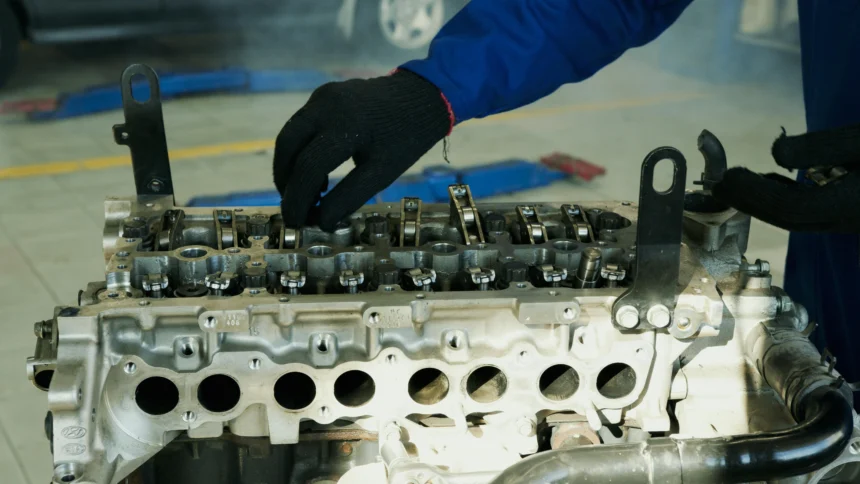Introduction
Motorcycle enthusiasts know that keeping their bike in good working condition is essential for smooth and reliable rides. However, sometimes you encounter issues that prevent the engine from starting normally. One common problem is when your VStar 1600 doesn’t start, often due to a dead battery or a faulty starter motor. In such cases, turning the engine manually can be a lifesaver.
This comprehensive guide will walk you through the entire process of manually turning the engine of a VStar 1600, with detailed steps, important tips, and troubleshooting advice. We’ll also look at essential maintenance practices to help you prevent issues from occurring in the first place.
Why Should You Know How to Turn the Engine Manually?
While it’s not something you’ll need to do often, understanding how to turn the engine manually on a VStar 1600 can be very helpful. Here are a few reasons why you might need to turn the engine manually:
- Dead Battery: When the battery dies and you don’t have jumper cables or a jump-start tool available, turning the engine manually helps you get the engine moving without relying on electrical power.
- Starter Motor Problems: If the starter motor malfunctions or is slow to turn over, manually turning the engine can bypass this issue.
- Seized Engine: Occasionally, internal parts of the engine might become stuck. Turning the engine manually can help break it free without damaging critical components.
- Pre-start Maintenance: Sometimes, before starting the engine after a long period of storage, turning it manually can ensure that oil circulates properly and components are not frozen in place.
By learning how to manually turn the engine, you can avoid potential frustration and get back on the road faster.
Tools Required for the Job
Before you begin, you’ll need a few tools to safely and effectively turn the engine manually. Below is a list of the most important tools you’ll need.
| Tool | Purpose |
| Socket Wrench | Used to loosen bolts and nuts, especially the crankshaft bolt. |
| Ratchet Extension | Adds leverage to make turning bolts easier. |
| Spark Plug Wrench | To safely remove and reinstall the spark plugs. |
| Oil Can | If the engine needs lubrication during the process. |
| Torque Wrench | Ensures that bolts are tightened to the correct specification. |
| Motorcycle Manual | A reference guide for specific instructions or torque values for your VStar 1600. |
These tools are essential for not only turning the engine but also ensuring that you perform the job correctly and safely.
Step-by-Step Guide: How to Turn the Engine Manually
The process of manually turning the engine on a VStar 1600 is fairly simple if you follow the right steps. It requires some basic mechanical knowledge, but with this guide, you should feel confident performing the task. Here’s how to do it:
1: Park the Motorcycle and Prepare It
- Find a Safe, Stable Area: Park your VStar 1600 on a flat, stable surface, such as a garage floor or driveway. Make sure that the bike is in an upright position and there’s enough space around you to work.
- Set the Motorcycle in Neutral: Ensure that the bike is in neutral so it doesn’t move while you’re working on it.
- Turn Off the Ignition: This is important for safety. Make sure the ignition is turned off to prevent the engine from starting accidentally during the process.
2: Remove the Spark Plugs
- Loosen and Remove Spark Plugs: Using a spark plug wrench, carefully loosen and remove the spark plugs from the engine. Removing the spark plugs is essential because it reduces compression and makes it easier to turn the engine by hand.
Why Remove Spark Plugs?- When the spark plugs are removed, the engine faces less resistance, making it easier to turn the crankshaft.
- It also prevents any risk of ignition while you’re manually turning the engine.
- Inspect Spark Plugs: This is a good time to inspect the condition of your spark plugs. If they look worn or dirty, it’s a good idea to replace them before reinstalling them later.
3: Locate the Crankshaft Pulley or Crankshaft Bolt
- Find the Crankshaft Bolt: The VStar 1600 features a crankshaft bolt, usually located on the right side of the engine. The crankshaft is a key component that rotates the engine. You will need to use this bolt to manually turn the engine.
- Refer to the Motorcycle Manual: For specific instructions on where to find the crankshaft bolt and any torque specifications, it’s best to consult your VStar 1600 manual.
4: Attach the Socket Wrench to the Crankshaft Bolt
- Attach the Socket Wrench: Fit the socket wrench to the crankshaft bolt. Ensure the wrench is properly attached, and the socket size matches the bolt.
- Use Ratchet Extension: If you need more leverage, use a ratchet extension. This gives you better control over the turning process.
5: Turn the Crankshaft Bolt Manually
- Start Turning: Turn the crankshaft bolt slowly in a clockwise direction (the normal rotation direction). Apply steady and controlled pressure. You should feel the engine start to turn as you rotate the bolt.
- Don’t Apply Excessive Force: If you encounter resistance while turning the engine, do not force it. You could cause damage to internal components. Instead, try turning the bolt a little in the opposite direction to release some tension, then try again.
- Check for Smooth Movement: As you turn the crankshaft bolt, check to see that the engine moves smoothly. You might feel a slight resistance as the pistons move through their cycle, but it should not feel stuck.
6: Reinstall the Spark Plugs
- Reinstall Spark Plugs: After successfully turning the engine, reinstall the spark plugs you removed earlier. Tighten them carefully using a spark plug wrench, ensuring they are snug but not overtightened.
7: Test the Engine
- Turn on the Ignition: Once the spark plugs are reinstalled, turn on the ignition to the “on” position.
- Start the Engine: Try starting the engine as usual. If everything has been done correctly, the engine should now start without any issues. If the engine doesn’t start, you may need to check the battery or other components.
Maintaining Your VStar 1600 for Better Performance
To avoid issues that require you to manually turn your engine, regular maintenance is crucial. Here are some key maintenance tasks you should perform to keep your VStar 1600 in top condition.
1. Regular Battery Checks
- Inspect Battery Connections: Check the battery terminals for corrosion. Clean them as necessary.
- Keep Battery Charged: Regularly charge your battery to ensure it’s ready to start the bike when needed.
2. Clean the Starter Motor
- Inspect Starter Motor: Over time, dirt and grime can build up on the starter motor. Clean it periodically to prevent malfunctions.
- Lubricate Components: If the starter motor feels sluggish, apply a lubricant that is safe for electrical parts.
3. Oil Changes
- Regular Oil Changes: Make sure to change your engine oil according to the manufacturer’s recommendations. Old or low oil can cause internal friction and make it harder for the engine to turn.
- Check Oil Levels: Always keep an eye on the oil levels to ensure smooth engine performance.
4. Inspect the Fuel System
- Fuel System Maintenance: Check fuel lines for leaks and ensure the fuel filter is clean. Clogged fuel lines can prevent your engine from starting.
Troubleshooting Common Issues
If you’ve followed all the steps and your engine still doesn’t start, here are a few additional things to check:
- Battery Issues: Double-check that your battery is fully charged and working properly.
- Faulty Spark Plugs: Worn-out spark plugs can prevent the engine from firing. Replace spark plugs as needed.
- Starter Motor Problems: A malfunctioning starter motor can be another reason the engine won’t start. In this case, you may need to repair or replace the starter motor.
- Clogged Fuel Lines: If your engine is turning over but won’t start, there may be an issue with your fuel system. Check for any blockages in the fuel lines or filter.
Conclusion
Learning how to manually turn the engine on a VStar 1600 is a useful skill that can help you in emergencies or when you’re dealing with a mechanical issue like a dead battery or a faulty starter motor. By following the steps outlined in this guide, you can easily and safely turn the engine and get back on the road. Additionally, regular maintenance and inspections of your bike’s components can help prevent issues from arising in the future.
By taking care of your VStar 1600 and being prepared for problems, you can ensure a long and enjoyable riding experience. Make sure to keep an eye on your battery, starter motor, spark plugs, and fuel system, and don’t hesitate to manually turn the engine if needed. This will give you peace of mind and help you avoid being stranded when something goes wrong.
FAQs on Turning the Engine Manually on a VStar 1600
Why would I need to turn the engine manually on a VStar 1600?
Turning the engine manually on your VStar 1600 can be necessary when your battery is dead, the starter motor isn’t working, or when the engine is seized. It helps get the engine moving without relying on electrical power.
What tools are required to turn the engine manually?
You’ll need a socket wrench, spark plug wrench, ratchet extension, and possibly an oil can for lubrication. These tools help loosen bolts, remove spark plugs, and make turning the engine easier.
Do I need to remove the spark plugs before turning the engine manually?
Yes, removing the spark plugs reduces compression, making it much easier to turn the engine manually. It also ensures no accidental ignition while you’re working on the engine.
How do I know if my engine is turning smoothly manually?
As you turn the crankshaft bolt, you should feel steady resistance. If the engine is turning without any unexpected hard stops, it’s likely moving smoothly. However, if you encounter excessive resistance, it could indicate an issue that needs further investigation.
Can turning the engine manually damage it?
If done correctly and without excessive force, turning the engine manually should not damage it. However, applying too much force or turning it the wrong way could potentially cause internal damage.
What should I do if the engine doesn’t start after turning it manually?
If the engine still doesn’t start, check the battery for charge, inspect the spark plugs for wear, and examine the starter motor. If all else fails, you might need to troubleshoot or replace faulty components.






